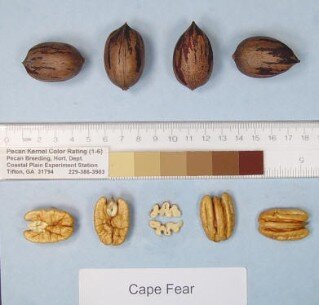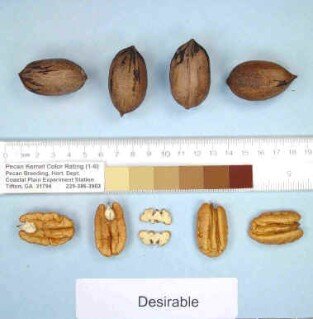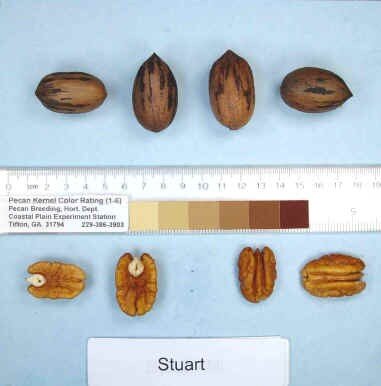The Legacy of the Pecan
Pecans. While there’s a debate on the proper way to say it (it’s pē-kan by the way), there is no argument about how awesome “Nature’s Health Food” is and the rich history it has.
Pecans are the only tree nut native to North America. Their name is derived from the Native American word “pacane” which roughly means “nuts requiring stone to crack.” The Native American people relied on the nutritious nut for sustenance and to make a fermented drink called “Powcohicora”. When Colonists were introduced to pecans, it was an immediate hit. Soon, orchards were being planted, and America would become the largest producer of pecans in the world.
Today, pecans are grown in about 15 states where 80% of the world’s supply is grown and harvested. Every year, the U.S. produced 300 million pounds of pecans. Since the 1700’s and early 1800’s pecans have been used in commerce. With the growing popularity and demand across the world, individuals began to experiment with grafting wild varieties, searching for the best pecans. This technique was not widely known until 1876 when a former African-American slave named Antoine successfully grafted a wild pecan to seedlings and won “Best Pecan Exhibited” at the Philadelphia Centennial Exposition.
Today, there are over 1,000 varieties with only about 20 used commercially. Many pecan varieties are named after Native American Indian tribes like the Cheyenne, Choctaw, and Pawnee.
The rich history of pecans is a special legacy in America, one that my family is proud to be a part of.
For as long as I can remember, we have had pecan trees on our family’s Century Farm. My Papa echoes similar memories as well. He remembers one of our largest and oldest pecan trees being planted in the 50’s, but whether it was bought or volunteered from the wild, he didn’t recall. His family would collect and sell the pecans to assist with farm income. That tree still stands today, producing pecan crops for us.
The “tassels” grow before the nuts.
The second oldest pecan tree on our farm is a Stuart variety and is in my grandparents’ backyard. Planted in 1978, it has grown and welcomed additional generations to the family. Often, you will find my grandparents outside with a bucket and pecan tool, picking pecans, counting every single one. You will also find my Papa at the window, pellet gun in hand, keeping watch for pecan thieves. Before you get worried, the thieves aren’t human. They are crows and squirrels, and they better beware Papa’s pecan tree.
Gideon helping pick up pecans
Painting I did for Papa featuring his pecan tree and a squirrel.
While most thieves have been of the wildlife variety, we have encountered some human ones. The old pecan tree stands alone in a field by the road. Those who recognize it as a pecan tree have stopped to help themselves. There have been several conversations with folks, letting them know that the old pecan tree is not a free-for-all. I only say this, to make people aware that going on private property (even if just a field) to collect a crop without permission is not okay.
A few years ago, my grandparents harvested 5 acres of pine trees and planted the acreage back with a pecan orchard. They chose 5 varieties—Stuart, Pawnee, Cape Fear, Desirable, and Gloria Grande. Each have their own history and qualities. Stuarts are were named for Col. Stuart who propagated the Castanera variety in the late 1800’s. Stuarts are the most widely known and widely planted cultivar in the Southeast. The Cape Fear, however, does not have as long of a history as the Stuart. Cape Fear was developed by Dr. Smit at NCSU in the 70’s. To read more about the history and quality of varieties, visit University of Georgia’s Pecan Breeding site.
Planning the orchard
The orchard has been a labor of love, with regular golf cart rides to check the trees, hand-watering during hot summers, fertilizing, pruning, and managing pests like bag worms.
Watering
The young pecan trees continue to grow, and some have even produced their first nuts.
Little pecan trees
Growing bigger
The rich history of pecans extends beyond the roots of the trees. They also have deep roots in the kitchen. Recipes featuring these nuts have been passed down from generation to generation, especially in the areas where the pecan is native. Some of my favorite recipes include pecans, and they are always made better when using nuts from the farm. Since moving to the Midwest, I have begun to ask for an annual supply of pecans from my grandparents’ farm as a Christmas gift to supply my baking needs.
For our family, there are a few recipes that really stick out as special pecan recipes: Pecan Pie, Candied Pecans, Pecan Pie Mini Muffins, and Carrot Cake. Each recipe is special. My Grandma’s pecan pie always makes a delightful appearance at Thanksgiving and sometimes birthdays. Grandma’s special candied pecans are a Christmas tradition. They are often gifted to friends and family, and there are always some in my bag on the return trip back home. Carrot cake has often made an appearance at birthdays and is never complete without some pecans. Finally, my Mom’s pecan pie mini muffins. They are the go to baked good for any occasion, but especially Christmas morning. They were a winning recipe in one of my first 4-H Favorite Food Show contests, and of course, I can never forget the night my mom and grandma drove to my college dorm room to deliver some pecan pie mini muffins. It was love and home in the form of a mini muffin.
While I can’t share all the recipes with you, I will share one in honor of National Pecan Month. Enjoy, from our family to yours.
Pecan Pie Mini Muffins
Pecans are more than another tree nut. They are America’s only native tree nut, have a rich history and have quite the legacy whether in the kitchen or on the farm. I’m proud that my family’s farm is a part of that legacy, and am oh, so thankful for my annual supply of homegrown pecans.
Sources: U.S. Pecans & Millican Pecan & University of Georgia























